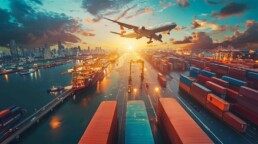Meet Your Digital Twin: The Rise of AI-Driven Clones
In an era of rapid technological advancement, digital twins have emerged as a transformative force across industries. These virtual replicas of physical entities, powered by advanced technologies like deep learning and natural language processing, are revolutionizing how we understand, monitor, and optimize complex systems. From manufacturing plants to entire cities, digital twins are creating unprecedented opportunities for innovation and efficiency. They are transforming the way industries operate and evolving toward increasingly sophisticated applications. The concept of digital twins originated in the early 2000s, primarily within the manufacturing and aerospace sectors. NASA pioneered early applications, using digital twins for space vehicle monitoring and simulation. Initially focused on physical assets like jet engines and oil rigs, these virtual replicas served primarily to improve operational efficiency and enable predictive maintenance. However, since then the technology has undergone a remarkable transformation. Early digital twins relied on basic sensor data and simple modeling techniques. Today’s versions incorporate artificial intelligence, machine learning, and advanced analytics to process complex data streams in real-time. Modern digital twins have evolved from simple monitoring tools into sophisticated platforms capable of complex simulations, real-time optimization, and predictive analysis. They now integrate vast networks of IoT sensors, advanced machine learning algorithms, and real-time data processing capabilities to create increasingly accurate and valuable virtual representations. Industries across the spectrum have recognized the potential of digital twins, something that is evident from the growth trajectory of the technology in recent years. According to Grand View Research, the global digital twin market reached $16.75 billion in 2023, with projections showing a remarkable CAGR of 37.87% from 2025 to 2030. This growth reflects the technology’s maturity, its expanding applications across industries and its ability to help organizations achieve cost efficiencies. Technology platforms are revolutionizing how industries create and utilize digital twins, enabling unprecedented levels of collaboration and simulation capabilities. These advanced platforms support real-time cooperation across global teams, physics-accurate simulations, and integration with multiple software tools, creating a new paradigm for virtual modeling and testing. Industry adoption has been particularly strong in specific sectors. The oil and gas industry, for instance, has been at the forefront of digital twin implementation, with Hexagon reporting that 43% of companies in this sector had deployed digital twin technology by 2022. These implementations have yielded impressive results, including substantial reductions in maintenance costs, improved equipment uptime, and enhanced safety metrics. The manufacturing sector has emerged as a primary beneficiary of digital twin technology. Modern factories utilize digital twins to create virtual representations of entire production lines, enabling real-time monitoring and optimization of manufacturing processes. For example, Volkswagen’s implementation of digital twins in their paint shops has resulted in significant energy savings and quality improvements. The technology enables manufacturers to identify and resolve potential issues before they impact production, leading to substantial cost savings and efficiency gains. The application of digital twins in urban environments represents one of the most ambitious implementations of this technology. Cities like Singapore and Dubai have developed comprehensive digital twin programs that transform urban planning and management. Virtual Singapore, a pioneering project in this space, demonstrates the potential for digital twins to address complex urban challenges. These urban digital twins integrate data from multiple sources, including traffic systems, utility networks, and environmental sensors, to create detailed virtual representations of city infrastructure. This integration enables city planners to simulate various scenarios, from traffic pattern changes to emergency response situations, leading to more informed decision-making and improved urban services. Modern hospitals utilize digital twins to optimize everything from patient flow to equipment maintenance, creating more efficient and responsive healthcare environments. Healthcare facilities have implemented digital twins to: The Cleveland Clinic’s implementation of digital twins for operating room management demonstrates the technology’s potential to improve healthcare efficiency and patient outcomes. Power plants, grid networks, and renewable energy installations utilize digital twins for real-time monitoring and optimization. These applications have proven particularly valuable in integrating renewable energy sources into existing power grids and managing the complexities of modern energy systems. The evolution of digital twin technology points toward a future where virtual and physical worlds become increasingly interconnected. Current trends and emerging technologies suggest several key directions for development that will shape how digital twins are implemented and utilized across industries. Artificial intelligence is becoming more sophisticated in its ability to analyze and act upon digital twin data. Advanced machine learning algorithms are enabling digital twins to move beyond simple simulation to predictive and prescriptive capabilities. For example, a major aerospace manufacturer is developing digital twins that can not only predict maintenance needs but also autonomously adjust aircraft component designs based on performance data across their fleet. Next-generation digital twins will offer unprecedented levels of simulation accuracy and complexity. Quantum computing developments are opening new possibilities for simulating molecular-level interactions in pharmaceutical development. In urban planning, improved simulation capabilities are enabling digital twins to model complex scenarios involving millions of variables, from climate change impacts to population movement patterns. As digital twins become more sophisticated, their role in decision-making is expanding. Manufacturing facilities are experimenting with systems that can autonomously adjust production parameters based on real-time market demand and resource availability. However, this increased autonomy raises new questions about human oversight and control mechanisms. A European chemical plant recently implemented a hybrid system where their digital twin can make routine operational decisions while requiring human approval for significant changes. The concept of personal digital twins is evolving beyond simple health monitoring to encompass broader aspects of individual life and decision-making. Healthcare providers are developing digital twins that can simulate patient responses to different treatments, while educational institutions are exploring personalized learning systems that adapt to individual student progress. These applications point toward a future where personal digital twins could serve as digital advisors, helping individuals make more informed decisions about their health, education, and daily activities. Digital twins are increasingly intersecting with other emerging technologies, creating new possibilities for interaction and application. The integration with blockchain technology is enabling more secure and transparent supply chain digital twins. Meanwhile, the development of 5G and eventually 6G networks will enable real-time synchronization of digital twins across vast distances with minimal latency. The rise of edge computing is also transforming how digital twins process and analyze data, enabling more responsive and efficient operations. The rapid advancement of digital twin technology brings forth a complex web of ethical considerations that industries must carefully navigate. These challenges transcend technical hurdles, touching on fundamental questions of privacy, accountability, and human agency in an increasingly digitized world. The implementation of digital twins requires vast amounts of data collection and processing, raising significant privacy concerns and calling for sophisticated measures to abate them. Examples:
Digital twins, like all AI-driven systems, can perpetuate and amplify existing biases if not carefully designed and monitored. In urban planning applications, for instance, digital twins might inadvertently prioritize services for certain neighborhoods based on historical data that reflects existing socioeconomic disparities. Examples:
As digital twins become more sophisticated in their decision-making capabilities, questions arise about the appropriate balance between automated and human decision-making. In healthcare settings, digital twins might recommend treatment plans or resource allocations, but the final decision must remain with human medical professionals. Examples:
The question of who bears responsibility when digital twin systems make errors or cause harm is increasingly complex. In manufacturing, for instance, if a digital twin’s predictive maintenance system fails to identify a critical equipment failure that leads to an accident, determining liability becomes complicated. Is the software developer responsible? The company operating the system? The manufacturers of the sensors providing the data? A recent case in the energy sector highlighted this challenge when a power plant’s digital twin failed to predict a critical component failure, leading to a temporary shutdown. The incident involved multiple stakeholders: the software provider, the sensor manufacturer, the system integrator, and the plant operators. The resulting legal discussion highlighted the need for clear frameworks defining responsibility and liability in digital twin implementations. The technical challenges of implementing digital twins are inextricably linked with social and ethical considerations. When a major port facility implemented a digital twin system to optimize container handling, they found that workers were initially skeptical of the system’s recommendations, highlighting the need for transparent communication and gradual implementation strategies. The implementation of digital twins must also consider cultural differences and global variations in privacy expectations and regulatory frameworks. What might be acceptable data collection in one culture could be considered invasive in another. For example, a multinational manufacturing company found that its digital twin implementation needed significant modifications across different global locations to accommodate varying cultural norms and regulatory requirements. Urban digital twins face similar challenges when implemented across different cultural contexts. A smart city system that works well in one country might need substantial modification to be acceptable in another, based on different cultural attitudes toward privacy and government oversight. Comprehensive regulatory frameworks are required to ensure a balance innovation with safety, security, and ethical considerations while providing standardization across industries and borders. Current regulatory developments are shaped by lessons learned from early implementations and emerging challenges across different sectors. The handling of sensitive data within digital twin systems requires robust protection standards. The European Union’s GDPR has become a benchmark for data protection, influencing how digital twin implementations handle personal and industrial data. As digital twins become more interconnected, the need for standardized communication protocols has become critical. The Digital Twin Consortium, comprising major technology companies and industrial players, is working to establish common standards for digital twin implementations. For example, Singapore’s digital twin initiative required the development of standardized protocols to enable communication between different systems managing traffic, utilities, and emergency services. The integration of digital twins with critical infrastructure necessitates robust security measures. The U.S. National Institute of Standards and Technology (NIST) has developed specific guidelines for securing digital twin implementations in critical infrastructure. These protocols became especially relevant after a series of cybersecurity incidents targeting industrial digital twins. including a 2023 attempt to compromise a power plant’s optimization systems. Different sectors require tailored regulatory approaches to address their unique challenges. In healthcare, the FDA has begun developing guidelines for the use of digital twins in medical device testing and patient care planning. Similarly, the aviation industry has established specific requirements for digital twins used in aircraft design and maintenance, ensuring they meet stringent safety standards. International organizations are working to establish frameworks for cross-border data sharing and system integration. For example, the International Organization for Standardization (ISO) is developing global standards for digital twin implementations, while international working groups focus on addressing challenges in global supply chain digital twins. Digital twins represent a transformative technology that continues to evolve and expand in scope and capability. From their origins in industrial applications to their emerging role in personal and urban environments, digital twins are reshaping how we interact with and optimize the world around us. As the technology matures, careful consideration of ethical implications and regulatory requirements will be crucial in ensuring its responsible development and deployment.The Evolution of Digital Twins
Market Growth and Technological Milestones
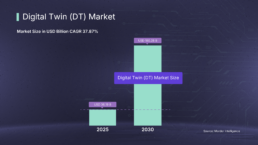
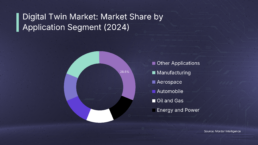
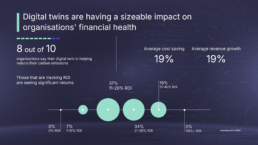
Transforming Industries
Manufacturing and Industrial Applications
Smart Cities and Urban Planning
Healthcare Systems and Operations
Model and optimize patient movement through facilities
Predict and prevent equipment failures
Improve resource allocation and staff scheduling
Enhance emergency preparedness and response
Monitor and control environmental conditionsInfrastructure and Energy
Emerging Applications and Future Horizons
Enhanced AI Integration
Improved Simulation Capabilities
Greater Autonomy in Decision-Making
Expanded Personal Applications
Integration with Emerging Technologies
Ethical Considerations and Challenges
Privacy and Data Protection
Bias and Fairness
Autonomy and Human Agency
Accountability and Liability
Technical and Social Challenges
Cultural and Global Considerations
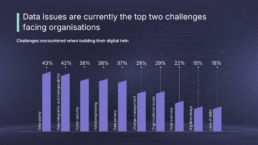
Regulatory Frameworks and Governance
Data Protection Standards
Interoperability Requirements
Security Protocols
Industry-Specific Regulations
International Cooperation
India's Race to 2047: Avoiding the Middle-Income Trap
India aims to achieve ‘Viksit Bharat’ by 2047, transitioning from middle to high-income status. India’s demographic dividend, growing middle class, and technological strengths offer advantages. However, addressing inequality, infrastructure gaps, skill development, and bureaucratic hurdles is crucial. ‘The World Development Report 2024: The Middle Income Trap’ examines the viability of India’s ambitious goal, highlighting that while the current trajectory shows promise, success is not guaranteed. Achieving this vision will hinge on the effective implementation of targeted strategies in the near term. India stands at a pivotal moment in its economic evolution. By 2047, the nation aims to shed the ‘developing’ tag and achieve ‘Viksit Bharat’—a bold vision to mark the centennial of its independence. The target over the next few years: Reaching a $5 trillion GDP in the next three years, scaling to $7 trillion by 2030, and becoming the third-largest economy in the world, overtaking both Japan and Germany. With the help of initiatives like ‘Atmanirbhar Bharat’ and ‘Digital India,’ the country is gearing up to become a global manufacturing powerhouse, in a bid to transition to the upper-middle-income category. However, there is one thing India must do to proceed on its upward trajectory—and that is avoid falling into the middle-income trap. It’s a trap that has thwarted the progress of many developing nations striving to advance to high-income status. Notably, since 1990, only 34 middle-income economies have managed to shift to high-income status. According to the World Bank, over a third of them benefited either from joining the European Union (EU) or from newly discovered oil reserves. In 2007, the World Bank published An East Asian Renaissance: Ideas for Economic Growth—the report that coined the phrase “middle-income trap.” It refers to a situation where a country struggles to transition into a high-income economy after experiencing rapid growth and reaching middle-income status. This happens when the factors that drove initial growth—such as cheap labor and capital accumulation—begin to diminish in effectiveness, and the economy fails to adapt through innovation, productivity improvements, or higher value-added industries. As per the recently released World Bank’s report titled, ‘World Development Report 2024: The Middle Income Trap’, it may take India close to 75 years, China more than 10 years, and Indonesia nearly 70 years to reach one-quarter of the United States’ income per capita. By 2023-end, 108 countries with a total population of six billion (75 percent of the world) were classified as ‘middle-income’. They each had annual GDP per capita between $1,136-13,845. They account for nearly 40 % of global economic activity, more than 60 percent of people living in extreme poverty, and more than 60 percent of global carbon dioxide (CO2) emissions, the report said. In some of these countries, ageing populations, slowing productivity, and reliance on low-wage manufacturing have hindered progress. Compounding these difficulties are major global challenges such as rising protectionism and the urgent need to tackle climate change and transition to clean energy. Here’s a look at three major challenges that India needs to tackle on a priority basis. Many developing nations that once boasted youthful demographics are now facing rapidly aging populations, and therefore labor shortages and increasing social welfare costs. However, India, with a median age of just 29, has time to reap the demographic dividend till 2050. India needs to capitalize on its young workforce. And this is possible only if there is heavy investment in health, education, productivity-enhancing technologies, upskilling the youth, and closing the gender gap. The rise of protectionism in advanced economies, particularly in the United States and parts of Europe, poses another challenge for countries like India. Tariff wars, stricter trade regulations, and an emphasis on onshoring industries are reshaping global trade dynamics. For India to become a manufacturing hub under the Make in India initiative, it must navigate this increasingly protectionist environment. Diversifying export markets, boosting domestic consumption, and improving trade relations with emerging markets in Africa and Southeast Asia can help mitigate the risks posed by protectionism. The global push toward decarbonization and renewable energy is the third major challenge. For many middle-income countries, including India, the need to transition to cleaner energy sources can be financially and logistically daunting. Fortunately, India has made significant strides in solar energy and other renewables, but the scale of the energy transition required remains enormous. To escape the middle-income trap, countries must focus on a comprehensive development strategy. The World Development Report 2024 recommends a “3i” strategy—Investment, Infusion, and Innovation—to help countries move forward. In 1960, South Korea’s per capita income stood at just $1,200. By end of 2023, that number had climbed to $33,000, as per World Bank. Once a war-torn country, agrarian economy, South Korea did this through export-led growth, by encouraging domestic firms to adopt foreign technology and by investing heavily in education. For a country like India, investment in infrastructure, education, and healthcare is crucial to boosting productivity and supporting long-term growth. Infusion refers to adopting and integrating new technologies to enhance productivity and competitiveness. With a strong focus on education, innovation, and EU integration, Poland avoided the middle-income trap by enhancing productivity and developing a diversified, knowledge-based economy. In India’s case, digital adoption has been rapid, but there is still room for further technological infusion, particularly in manufacturing and agriculture. Once a middle-income country has begun to exhaust the potential of infusion in the most promising parts of its economy—running out of technologies to learn and adopt—it should expand its efforts to become an innovation economy, recommends the report. After all, moving from a labor-intensive, low-wage economy to a high-income economy requires countries to shift from copying technologies to creating them. Chile, though a smaller economy, became the first Latin American country to reach high-income status. A key factor was its focus on innovation and technology transfer. By adapting Norwegian salmon farming techniques to its unique environment, Chile became a leading salmon exporter. The good news is India already has a growing tech and startup ecosystem. By investing in new technologies, encouraging entrepreneurship, and fostering innovation, India can build industries of the future. India’s aspirations are grand, but they are not unattainable. India is well-positioned to avoid the middle-income trap, provided it takes bold steps toward structural reforms, fosters a culture of innovation, and leverages its demographic dividend. Learning from other nations’ experiences, while charting its own path, will help India achieve its vision of becoming a global economic powerhouse.India’s path to high-income status
What is the middle-income trap?
Lessons from the past 50 years show that as countries grow wealthier, they usually hit a “trap” at about 10% of annual US GDP per person—the equivalent of $8,000 today. That’s in the middle of the range of what the World Bank classifies as “middle-income” countries. World Development Report 2024: The Middle Income Trap

Challenges ahead
Reaping the demographic dividend
Rising protectionism
Combatting climate change
Escaping the trap with the 3i strategy
Quantum Computing: Leapfrogging to The Future
In 2023, IBM introduced its 433-qubit Osprey processor, while Google’s Sycamore demonstrated quantum supremacy by completing a calculation in just 200 seconds—something that would take the fastest classical supercomputers over 10,000 years. These breakthroughs are not just milestones; they signal a monumental leap from theory to reality. Quantum computing is here, and it’s set to revolutionize artificial intelligence and reshape entire industries. The concept of quantum computing emerged in the early 1980s when physicist Richard Feynman proposed harnessing quantum mechanical phenomena for computation. His insight came from the difficulty of simulating quantum systems using classical computers. Shortly after, David Deutsch described the first theoretical quantum computer, introducing the world to the possibility of solving complex problems exponentially faster than classical computers. However it was in 1994 that MIT mathematician Peter Shor published one of the first practical real-world applications for a quantum machine. His algorithm for integer factorization showed how a quantum mechanical computer could potentially break the most advanced cryptography systems of the time—some of which are still used today. Shor’s findings demonstrated a viable application for quantum systems, with profound implications for fields beyond just cybersecurity. Quantum computing leverages the fascinating principles of quantum mechanics – the branch of physics that deals with the behaviour of subatomic particles. – electrons, photons, quarks, neutrinos and more. Now, photons are quantum particles that make up light. Experiments by scientists in the early 20th century showed how a photon with high enough frequency can knock an electron free from the surface of a metal. Another way to understand this is that just trying to get a better look at a subatomic particle would change the momentum of the electron. This emerging technology spans multiple scientific domains, including the development of quantum hardware and the creation of specialized quantum algorithms. Though the field is still maturing, quantum computers promise to tackle computational challenges that lie far beyond the reach of even our most advanced classical supercomputers. Quantum computers harness the counterintuitive behaviors of subatomic particles to perform certain types of calculations with unprecedented efficiency. While classical computers use binary bits – zeros and ones – to store and process data, quantum computers leverage quantum bits or qubits, which can hold far more information due to their ability to exist in superposition (the ability to exist in multiple states at once). This essentially means that while a binary bit holds a fixed value (0 or 1), a qubit can be both 0 and 1 at the same time. This is the strange and nearly inexplicable behaviour of quantum mechanics that this QC harnesses. Quantum computing enhances AI by accelerating data processing and model training. Several specific advantages include:
Conversely AI plays a key role in the development and optimization of quantum systems:
Quantum Computing has recently reached a crucial milestone with IBM aiming for a 4,000+ qubit system by 2025. Meanwhile, governments worldwide are investing heavily in quantum research, recognizing its potential impact on national security and technological advancement. China has reportedly invested $10 billion in a national quantum laboratory, while the US has committed $1.2 billion to the National Quantum Initiative. Though a fully functional, error-corrected quantum computer remains years away, the progress in recent years suggests we’re moving steadily toward this revolutionary technology. In 2023, private and corporate investments in quantum technology (QT)* start-ups experienced a 27% decline, totaling $1.71 billion, down from $2.35 billion in 2022. This decrease was less severe than the 38% drop observed across all global start-up investments during the same period. Notably, 62% of the QT funding was directed toward companies established five or more years ago, indicating a strategic focus on scaling mature start-ups. In contrast, public investments in QT surged by over 50% in 2023, accounting for nearly a third of all QT investments. Countries such as Germany, the United Kingdom, and South Korea announced substantial new funding, bringing total global public investment to approximately $42 billion. The quantum computing (QC) industry is undergoing rapid growth, as reflected in a recent McKinsey survey of industry leaders. The survey highlights a shift in the size and scale of companies in the sector: firms with fewer than six employees have increased from 0% to 11%, while those with over 100 employees have risen from 9% to 39%. This indicates both the emergence of new players and the scaling up of established companies, signaling progress toward fault-tolerant quantum computing (FTQC). Fault-tolerant QC refers to a system capable of performing quantum computations reliably, even in the presence of errors. Unlike today’s noisy intermediate-scale quantum (NISQ) systems, FTQC would use error-corrected qubits to process information more accurately and execute long computations without failure. Over 65% of surveyed experts expect FTQC to be achieved by 2030, though debates persist regarding whether “true” fault tolerance requires large-scale logical qubits or whether high-error tolerance with minimal correction suffices for useful applications. Progress toward FTQC is evident in the rise of practical QC use cases, with 55% of respondents now having an in-production use case, up from 33% the prior year. Sectors like aerospace, automotive, oil and gas, and medical technology are among the early adopters likely to benefit from these advancements. In India, the government has taken significant steps to bolster the quantum technology sector. The National Quantum Mission, approved by the Union Cabinet with a budget of ₹6,003.65 crore (approximately $730 million) for 2023–2031, aims to advance quantum technologies in alignment with national initiatives like Digital India and Make in India. This mission focuses on developing quantum computing, communication, sensing, and materials, with the establishment of Thematic Hubs (T-Hubs) at premier institutions such as the Indian Institute of Science (IISc) Bengaluru and various Indian Institutes of Technology (IITs). These efforts underscore India’s commitment to scaling established start-ups and fostering innovation in the quantum technology landscape. Quantum computers can perform certain calculations exponentially faster than classical computers. This capability becomes particularly crucial for problems like cryptography, drug discovery, climate modeling, and optimization challenges that are practically impossible for traditional computers to solve. This makes quantum computing the potential key to breakthroughs in a number of critical industries.
Technological: The primary challenge in quantum computing lies in maintaining quantum coherence – keeping qubits in their quantum state long enough to perform calculations. Environmental factors like temperature, electromagnetic radiation, and physical vibrations can cause “decoherence,” destroying the quantum properties essential for computation. Engineers must also tackle the challenge of scaling up quantum systems while maintaining precise control over individual qubits. Error correction remains another significant hurdle, as quantum systems are inherently prone to errors that must be detected and corrected without disturbing the quantum state. Scalability: Challenges persist, including limited access to advanced hardware, low awareness of QT applications, and inadequate interdisciplinary collaboration between academia and industry. To overcome these hurdles, coordinated innovation clusters are emerging globally. These partnerships between researchers, industry leaders, and governments aim to advance QT development, manage intellectual property, and drive regional technological value creation. A sustainable quantum ecosystem depends on three pillars: talent development, effective collaboration, and realistic expectations. Talent Development Talent development in quantum computing saw significant progress in 2023, with 367,000 graduates earning QT-relevant degrees. The number of universities offering QT programs grew by 8.3% to 195, and those offering master’s degrees increased by 10% to 55. The European Union and the United Kingdom lead in graduate numbers and density, respectively. Collaboration Models Managing Expectations Focusing on these priorities will create an ecosystem capable of supporting QC’s long-term growth and delivering transformative technologies. Quantum computing stands at a pivotal moment in its evolution. While companies have achieved significant milestones, the industry is moving from experimental phases toward practical applications with India throwing its hat in the ring through its National Quantum Mission. With talent in the field only set to grow further, experts are more than hopeful that fault-tolerant quantum computing will be achieved by 2030, which would mark a revolutionary breakthrough. While challenges persist, the increasing number of practical use cases across industries and the growing ecosystem of researchers, industries, and governments suggest we’re steadily advancing toward a quantum-enabled future.The Birth of Quantum Computing
But wait! What is Quantum Computing?
Bringing the Quantum Edge to AI
AI for Quantum Computing
Economic Landscape: Current State and Progress of Quantum Computing
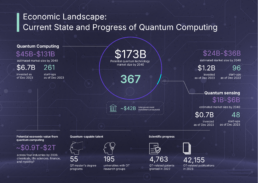
The Investment Scenario: Private v/s Public
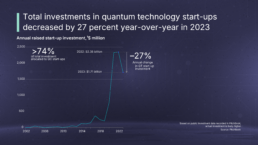
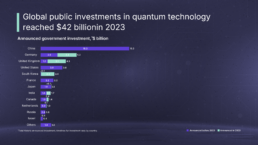
QC Players Scaling Up
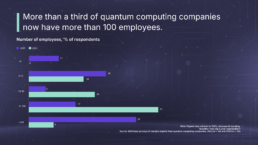
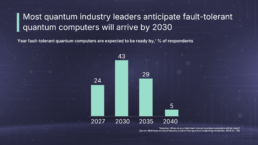
India and the Quantum Race
Use-cases for Quantum Computing
Challenges
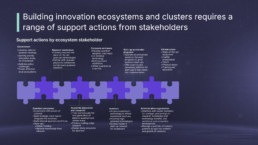
Building a Sustainable Quantum Ecosystem
Building a skilled workforce requires expanding the talent pipeline beyond traditional physics PhDs. Programs introducing quantum concepts at earlier educational stages can prepare students for the unique challenges of QC.Quantum Talent on the Rise
Strong partnerships among academia, industry, and governments are essential for advancing QC. Reducing bureaucratic barriers, fostering open-source tools, and securing venture capital will drive innovation and enable practical applications.
Clear communication about the current state and future potential of QC is crucial to avoid disillusionment. Transparent updates and realistic goal-setting will maintain trust and ensure that stakeholders remain engaged in advancing the field.
Going Beyond Borders: The supply chain revolution
Ever wondered how your online purchase could reach your doorstep within days? That’s the power of a well-connected global supply chain that forms the backbone of international trade. It connects manufacturers and consumers while driving efficiency through technological advancements and just-in-time production. However, this intricate network is increasingly confronted with a myriad of challenges. This article explores the current challenges facing the global supply chain and outlines potential pathways for enhancing its robustness in an ever-changing landscape. A global supply chain is the network of businesses, resources, people, and processes involved in producing and delivering goods and services across different countries.
The modern global supply chain is the backbone of international trade, connecting businesses, manufacturers, and consumers worldwide. But we live in an era of constant disruption, rapid digitization and growing consumer demands, which makes global supply chains a complex ever-evolving vortex. Supply chain disruption is now the norm. Congestion of transportation and logistics infrastructure, geopolitical shifts, natural disasters and extreme weather, raw material shortages, are just a few of the factors that affect the global supply chain. As global supply chains span continents, they often pass through critical chokepoints that can become bottlenecks, creating vulnerabilities and highlighting the need for robust contingency planning. Here’s a closer look at the challenges faced by the global supply chain and the strategies companies are adopting to mitigate potential disruptions in it. Major international ports, which act as hubs for global shipping, face several challenges, from labor strikes and infrastructure limitations to congestion. The Suez and Panama Canals significantly reduce transit times for ships. With over 80% of global trade relying on maritime routes, these canals serve as the lifelines of the supply chain, making their efficiency and stability essential. Any disruptions in these routes disrupt global trade, delaying shipments and causing backlogs at ports. The prolonged lockdowns, labor shortages, and factory closures during the COVID-19 pandemic highlighted several vulnerabilities in the global supply chain. Additionally, there were demand fluctuations, production delays, rising freight costs, inventory shortages, and transportation limitations that caused further disruptions. Companies were forced to rethink their supply chain strategies, emphasizing the need for more resilient and flexible operations to mitigate such risks in the future. Global supply chains often face labor shortages, but addressing these issues requires a focus on ethical labor practices. Ensuring fair wages, safe working conditions, and preventing exploitation are critical. Companies must adopt transparent policies, adhere to labor laws, and collaborate with stakeholders to promote sustainability and human rights in their supply chains. In 2023, a report by the International Road Transport Union (IRU) found that truck driver shortages had increased globally. There were over 3 million unfilled truck driver positions in 36 countries, or 7% of total positions. The truck driver shortage is a significant bottleneck in the global supply chain, particularly in the US and Europe, caused by factors such as aging driver populations, stricter regulations, and low recruitment rates. The IRU predicts that the shortage will double by 2028. Geopolitical conflicts are among the biggest threats to the global supply chain. Escalating tensions can disrupt the availability of everyday products, affecting everything from essential goods to advanced electronics.
It’s no secret that the ongoing tension between two of the world’s biggest superpowers, the US and China, has significantly impacted global trade. A key consequence has been the increasingly protectionist stance adopted by the US since 2018, marked by higher tariffs, revisions to or withdrawals from free-trade agreements, and trade restrictions with countries deemed strategic threats. Several other nations are also moving toward similar policies, reshaping trade agreements and pressuring companies to localize production and reassess global supply networks. These trade conflicts, along with rising tariffs, have compelled businesses to diversify suppliers and shift production to mitigate risks, often driving up costs and adding complexity. Trade policies essentially strike the global supply chain networks, not only changing product flows but also disrupting supply chains. In a hyper-globalized world, shifting trade regulations across countries are creating more challenges for global businesses, as they must navigate new rules, tariffs, and compliance measures, disrupting established supply chains. An example of this is Brexit in December 2020, which introduced new regulatory barriers, customs checks, and increased border delays as the UK departed from the European Union (EU). As a result, between 2021 and 2023, UK exports to the EU fell by 27% and imports fell by 32%, a report by Aston University Business School has found. Sanctions and embargoes are powerful tools used by countries and international bodies to influence the behavior of nations and organizations by restricting their economic activities. For instance, in response to Russia’s actions in Ukraine, several countries and international organizations have imposed sanctions targeting key sectors of the Russian economy, including finance, energy, and defense. These sanctions have disrupted trade and investment flows, affecting both Russian and global markets. Likewise, there are several international sanctions imposed by Western countries on nations like Iran, North Korea, and Venezuela, disrupting global trade flows and limiting access to markets and resources. Today’s supply chains face unprecedented political pressures in what McKinsey & Company calls a “fragmenting global order.” Three major disruptions illustrate this reality:
A new wave of challenges is materializing for global supply chains. The rise of digital operations has increased the risk of cyberattacks and software issues, while disruptions caused by extreme weather events too are becoming increasingly frequent. Cyberattacks occur when malicious actors exploit vulnerabilities in software, networks, or systems to gain unauthorized access, disrupt services, or steal sensitive information. These attacks can take various forms, such as phishing, malware, ransomware, and denial-of-service (DoS) attacks. Stay vigilant: These incidents demonstrate how sophisticated cyber attackers can infiltrate widely used software, compromising supply chains and affecting thousands of businesses globally. Staying vigilant by regularly updating software, implementing firewalls, and using encryption to protect sensitive data is more crucial than ever. Regular security audits and implementation of zero-trust architecture are needed to stop such attacks. Even at an individual level, employing strong, unique passwords, multi-factor authentication (MFA), and conducting employee cybersecurity training are essential steps in enhancing overall security. Natural disasters and extreme weather events, such as hurricanes, typhoons, and wildfires, are becoming more frequent and intense, damaging critical infrastructure, disrupting transportation, and delaying production. Disruption due to climate-related catastrophic events could lead to $25 trillion net losses by mid-century, according to a study by Nature. Here are a few climate-related catastrophic events that disrupted global supply chains in 2023 and 2024: The key to resilience lies in developing an agile and global supply chain model capable of responding swiftly to changes. Agility allows companies to pivot and adapt in the face of unexpected challenges, while a global supply chain network provides access to a wider range of resources and markets. Businesses can reduce their dependence on a single source by sourcing materials or products from multiple suppliers across different regions. Supplier diversification has the potential to mitigate risks related to geopolitical tensions, natural disasters, or other localized disruptions. For example, when the U.S.-China trade war intensified, many companies began diversifying their supply bases to other parts of Asia, such as Vietnam and India, to reduce reliance on China. Nearshoring, or relocating production closer to home markets, enhances supply chain agility by shortening lead times, reducing transportation costs, and improving oversight. It also allows for faster adjustments to meet market demands. This technique enabled businesses to reduce their response times, especially during the pandemic. Leveraging advanced technologies enables companies to forecast and anticipate demand fluctuations and potential disruptions and take proactive measures to tackle potential supply chain bottlenecks before they occur.
The future of supply chain management will be shaped by a combination of sustainability, transparency, and innovation. Like everything else in the world, supply chains too must evolve to preserve the future of our planet, reducing their environmental impact and embracing ethical practices. By integrating cutting-edge technologies and eco-friendly models, businesses can ensure they not only meet consumer expectations but also contribute to a more resilient and responsible global economy.
The evolving landscape of globalization and digitization demands a transformative approach to supply chain management. Businesses must leverage technology for real-time visibility, adopt data-driven decision-making, and build collaborative partnerships to remain competitive. Agility and foresight have proven indispensable in navigating post-pandemic challenges, enabling businesses to withstand disruptions and maintain operational continuity. Resilient supply chains not only safeguard market positions and optimize costs but also foster trust by consistently delivering value to consumers. Looking ahead, the future of global supply chains will be shaped by several key factors:What is the global supply chain?
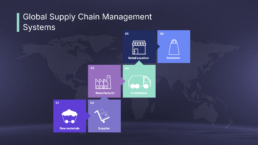
Critical chokepoints in the global supply chain
Suez Canal, Panama Canal, and major international ports
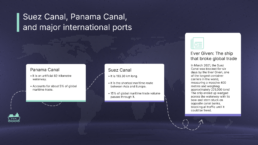
Disruptions in a post-pandemic world
Labor shortage
Truck driver shortage in 2023
Geopolitical jitters
Rising protectionism
Trade Turbulence
The Geopolitical Storm
The transformation of Black Sea ports from vital trade hubs to conflict zones has upended global food supply chains.
Escalating technology restrictions and tariffs have forced companies to restructure their entire supply networks.
Recent Red Sea disruptions have compelled shipping companies to choose between risk and costly detours.Emerging threats in 2025
Cyberattacks
Climate-related catastrophic events
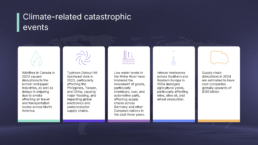
How to build a more resilient supply chain
Diversification of Suppliers
Nearshoring
Adopting new technologies
Emerging Trends: The supply chain of the future
A transformative approach
Governments will play a pivotal role through policies that encourage trade, infrastructure investments, and environmental regulations, ensuring equitable and sustainable growth.
Developing countries can take advantage of the global supply chains which offers opportunities for economic advancement and job creation.
Consumers, too, wield significant influence through their choices, driving companies to adopt sustainable, transparent, and ethical practices. As businesses strive to balance efficiency, resilience, and sustainability, they must focus on creating supply chains that not only meet present needs but also contribute to a sustainable and equitable future for all.
Reaching for the stars: A guide to the Space Economy
The final frontier is no longer a passive opportunity—it’s a strategic imperative. What was once the domain of science fiction has transformed into a critical economic battlefield, where innovative nations and forward-thinking enterprises are redefining the boundaries of technological and economic potential. The space economy represents more than an emerging market; it’s a transformative force reshaping global competitiveness, technological innovation, and sustainable development. The global space economy, valued at $630 billion in 2023, encompasses far more than just rockets and satellites. It can be divided into two main segments: Backbone Applications ($330 billion) These are direct space-related revenues from:
Reach Applications ($300 billion) These are enabled by space technologies but generate revenue in terrestrial industries:
In the last few years, the space economy has become an integral part of driving the global economy. From job creation and economic growth to technological advancements with applications in other related industries— it offers a multitude of benefits. Today, it holds the power to even tackle some of the world’s biggest challenges like climate change and help build a more sustainable and inclusive future. The space economy is projected to reach $1.8 trillion by 2035, growing at an impressive 9% annually—nearly double the expected global GDP growth rate of 5%. For context, this growth puts it in league with:
Seven industries will dominate the space economy, representing over 80% of combined backbone and reach revenues: Supply Chain and Transportation Food and Beverage State-sponsored Defence Retail, Consumer Goods/Electronics and Lifestyle Media, Entertainment and Sports State-sponsored Civil Programs Digital Communications
The space economy rests on three fundamental pillars that drive innovation, sustainability, and human advancement beyond Earth’s boundaries: Modern satellites achieve sub-meter navigation precision while offering truly global communication coverage. Their impact extends from city planning to farming practices, with environmental monitoring systems projected to help reduce greenhouse gas emissions by 2 gigatons annually by 2030. This pillar represents humanity’s quest for knowledge through increasingly collaborative international missions. Using next-generation telescopes and probes, scientists are expanding our catalog of exoplanets while studying potentially habitable environments and cosmic phenomena. The unique zero-gravity environment enables revolutionary manufacturing techniques, including specialized 3D printing. This capability, combined with the potential to harvest valuable resources like water ice, Helium-3, and rare minerals, opens new possibilities for constructing large-scale space structures. The focus remains on sustainable practices through in-situ resource utilization – using materials found in space for space-based construction and operations.
The remarkable growth of the space economy is powered by four interconnected forces that are fundamentally transforming how we access and utilize space: The economics of space have been revolutionized over the past two decades. Launch costs have plummeted by 90%, while satellite manufacturing benefits from unprecedented economies of scale. Data services continue to become more affordable, with the cost per bit declining steadily. These cost reductions have transformed space from an exclusive domain into an accessible business frontier. Innovation is reshaping space technology at every level. Components are becoming smaller yet more powerful through aggressive miniaturization. Advanced software is enabling autonomous operations and improved data processing. Meanwhile, manufacturing efficiency has leaped forward with automated production lines and standardized processes, allowing for faster, more reliable space hardware development. The space sector is experiencing unprecedented financial interest. Private investment has reached record levels, attracted by new market applications ranging from satellite communications to space tourism. The investor base has broadened significantly, including venture capital, private equity, and even retail investors, creating a robust funding ecosystem for space ventures. Space has captured public imagination like never before. Growing public engagement through media coverage and educational initiatives has created widespread support for space activities. Governments worldwide are increasing their space budgets and developing supportive policies. Commercial companies are actively participating in space activities, from satellite deployment to space tourism, further normalizing space as a domain for business and innovation. In 2023, global space activities reached unprecedented levels, with 223 orbital launch attempts and 2,911 satellites deployed. The United States led with 109 launches, followed by China with 67, and Russia with 19. Commercial satellites dominated, accounting for 2,626 of the total, reflecting the private sector’s growing influence. Military space operations saw advancements in surveillance, imaging, and signals intelligence, with notable contributions from the U.S., China, and Russia. Both the International Space Station and China’s space station expanded their operations, hosting multiple crewed missions. However, the surge in launches intensified concerns over space debris, underscoring the need for enhanced orbital traffic management. The space economy is not merely an industry—it’s a strategic platform for global problem-solving and economic reinvention. As we approach 2035, with a projected market value of $1.8 trillion, this sector transcends traditional economic boundaries. It represents a new strategic domain where technological innovation, economic opportunity, and global challenges converge. For forward-thinking organizations and nations, the space economy is a critical battleground of innovation. The decreasing cost of space access, combined with unprecedented technological capabilities, means that strategic positioning is no longer optional—it’s essential. Those who view space not as a distant frontier, but as an integral part of their strategic ecosystem, will lead the next wave of global economic transformation. This isn’t just about reaching for the stars—it’s about reimagining what’s possible for our planet, our economies, and our collective future. The space economy is the ultimate strategic canvas, where imagination, technology, and ambition intersect to solve humanity’s most pressing challenges.Understanding the Space Economy
Growth Trajectory and Impact
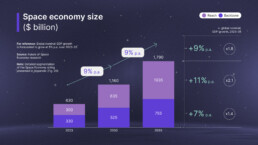

What is driving this growth? Here’s a quick look
Key Growth Metrics
Space economy size by industry ($ billion)
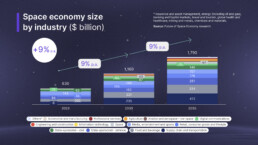
Core Pillars of the Space Economy
Market Drivers: Propelling the Space Economy Forward
Cost Reduction: Making Space Accessible
Commercial Innovation: Accelerating Technological Progress
Investment Diversification: Expanding Financial Horizons
Cultural Momentum: Building Public Support
A look at the countries that are leading the space race
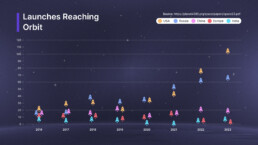
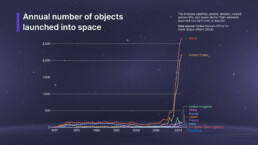
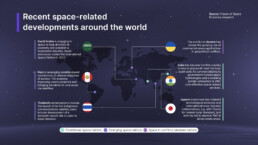
The promise of space: What can space help us tackle?
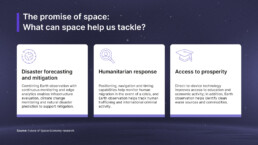
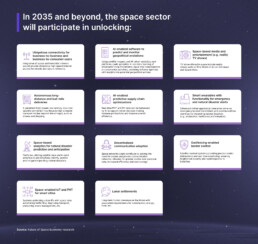
Looking Forward: The Space Economy's Promise
A Safety Net for Planet Earth
The climate crisis isn’t some distant threat; it’s here, demanding urgent action. In this evolving reality, the tools of yesterday are no longer enough. We need bold, innovative solutions to chart a path forward—solutions like decarbonizing our atmosphere, conserving carbon sinks– forests and oceans and embracing cutting-edge practices like carbon sequestration. In this piece, we explore how modern solutions can address modern-day problems by working with nature. By leveraging nature’s strengths and infusing modern ingenuity, we can redefine what’s possible and secure a livable planet for generations to come. The time to act is now. Sustainability is about ensuring our society can thrive today without jeopardizing the resources future generations will need. Climate change refers to long-term shifts in temperatures and weather patterns, primarily driven by human activities since the 1800s, such as the burning of fossil fuels. The resulting increase in GHG emissions is causing widespread environmental impacts, including polar melting, glacial retreat, thawing permafrost, and extreme weather events like floods and droughts. These changes lead to coastal erosion, the death and displacement of flora and fauna, wildfires, and the destruction of ecosystems. Human systems are equally affected, with crop destruction, loss of livelihoods, increased disease, and climate-induced migration, creating a cycle of escalating consequences. Minerals, forest products, water, and soil are just a few of the natural resources that we use to produce energy and are essential for our daily lives. Natural resources can be divided into two categories: renewable and nonrenewable. Renewable resources, like sunlight, air, and water, can be replenished and reused. But nonrenewable resources, such as fossil fuels (coal, oil, and gas), are limited and take millions of years to form. Burning these nonrenewable resources releases harmful GHGs like carbon dioxide. Without controlling these emissions, CO2 levels will rise. The result: Global warming and a rise in catastrophic events across the planet. Currently, the annual global carbon footprint is around 50 billion tons of CO2 equivalent emissions which means we have 8 years left until we spend our carbon budget if today’s levels of releasing emissions are kept. The solution to this problem is starting immediately with emissions reduction at a gradual pace and taking out the historically built-up CO2 from the atmosphere. As the effects of climate change intensify, countries and industries alike are seeking modern ways to meet emissions targets. Techniques like decarbonization and carbon sequestration show how we can work with nature to confront the climate crisis head-on. Decarbonization is a lifeline for a planet grappling with the weight of human-induced emissions. It’s not just good—it’s essential! By transitioning away from fossil fuels to renewable energy sources like solar, wind, and hydropower, we can fundamentally reshape our energy landscape. Decarbonization isn’t just about technology; it’s about systemic change. It requires a reimagining of economies, industries, and lifestyles. From rethinking how energy is generated to reinventing transportation systems and adopting regenerative land management practices, every aspect of how we live and work must evolve. Decarbonization refers to the process of reducing CO2 other GHG emissions from the atmosphere, resulting from human activities such as energy production and consumption. It involves transitioning from fossil fuels like coal, oil, and natural gas to cleaner, renewable energy sources such as solar, wind, and hydropower. It also encompasses improving energy efficiency, adopting sustainable practices in industry and transportation, and enhancing carbon capture and storage technologies. By lowering CO2 emissions, decarbonization plays a crucial role in mitigating climate change. The beauty of decarbonization lies in its dual impact—it protects the planet while unlocking new opportunities for innovation, economic growth, and equity. It calls for collective effort but promises shared rewards: cleaner air, resilient ecosystems, and a sustainable legacy for future generations. Carbon sequestration is the capturing, removing, and permanently storing of CO2 from the earth’s atmosphere. But is it enough? Currently, about 45% of the CO2 emitted by human activities remains suspended in the atmosphere, driving global warming. Carbon sequestration is critical to reducing this dangerous buildup and preventing further emissions from contributing to the heating of the planet. The importance of carbon sequestration lies in its ability to offset emissions that cannot be immediately eliminated. Nature has long been our ally in this effort through biological sequestration. Forests, grasslands, soils, and oceans act as vital “carbon sinks,” absorbing vast amounts of CO2 and helping to balance the global carbon cycle. However, these natural systems are under increasing strain due to deforestation, land degradation, and ocean acidification, which weaken their capacity to perform this critical function. Geological sequestration offers a technological counterpart, storing CO2 deep underground in rock formations or other geological structures. Advances in artificial carbon-trapping methods are opening new doors. Direct air capture technology, for instance, removes CO2 directly from the air, while Carbon Capture and Storage (CCS) systems intercept emissions from industrial processes before they reach the atmosphere. They can then be compressed and transported to deep underground facilities, where they are injected into rock formations for permanent storage. Despite these advancements, the scale of sequestration efforts remains far from adequate. As of February 2024, capture capacity that is either already in operation or has reached FID still accounts for just 20% of announced capture capacity for 2030 (Source: IEA). As of 2024, CCS was in operation at 44 plants worldwide, collectively capturing about one-thousandth of global carbon dioxide emissions. 90% of CCS operations involve the oil and gas industry. CCS could have a critical but limited role in reducing greenhouse gas emissions. To meaningfully impact climate change, efforts must be ramped up exponentially. The biggest challenge is the pressing need for financial support mechanisms from national governments through international collaboration, apart from investment in research and infrastructure. In the face of climate change, sustainability has shifted from a mere buzzword to a critical global necessity. With a heightened sense of urgency and the advent of new technologies, sustainability efforts are reshaping life in unprecedented ways. Understanding these evolving dynamics is crucial as we navigate the path toward a more sustainable future.What is sustainability?
“Meeting the needs of the present without compromising the ability of future generations to meet their own needs.” — The United Nations Brundtland Commission’s definition of sustainability in 1987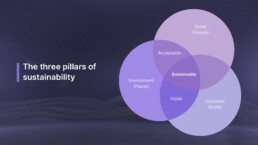
Why does sustainability matter?
Mitigating climate change
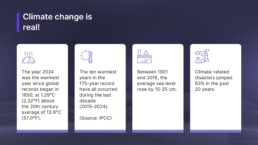
Conserving natural resources
What will happen if we don’t live sustainably?
From Crisis to Cure: The Global Race to Save the Planet
Fundamentals of decarbonization
What is decarbonization?
How is it beneficial?

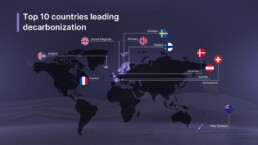
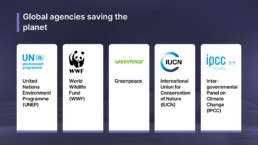
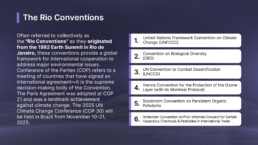
Carbon sequestering: The science behind carbon sinks
Greenwashing: The Rising Threat to Genuine Sustainability
Imagine a world where every product you buy promises to save the planet—cleaner oceans, greener forests, and brighter futures. Sounds perfect, doesn’t it? But what if these promises were just clever disguises, hiding practices that do more harm than good? Welcome to the shadowy realm of greenwashing, where words like “eco-friendly” and “sustainable” often mask false solutions to the climate crisis. In this Essentials Guide, we’ll peel back the layers of marketing spin, arm you with the tools to decode green claims, and help you make informed choices that truly benefit the planet. Read on to equip yourself to uncover the truth behind the green veil. It is the act of making false or misleading statements about the environmental benefits of a product or practice. It can be a way for companies to continue or expand their polluting as well as related harmful behaviors, all while gaming the system or profiting off well-intentioned, sustainably-minded consumers. Greenwashing is neither good for consumers nor businesses. In a world where time is of the essence in order to tackle climate change, greenwashing is more than just misleading—it’s dangerously counterproductive. At its core, greenwashing undermines trust, deceiving consumers into believing they are supporting eco-friendly products or practices when, in reality, they are not. This misrepresentation not only exploits the good intentions of eco-conscious individuals but also diverts their support away from businesses making genuine efforts to address environmental issues. The harm of greenwashing extends beyond consumer deception—it creates a significant barrier to progress in combating the climate crisis. When companies prioritize appearances over meaningful action, they delay critical changes needed to reduce carbon emissions, preserve natural resources, and support sustainable development. This ultimately slows down innovation and investment in truly green solutions. These are the common tactics used in greenwashing: Chevron’s “People Do” campaign: In the mid-1980s, Chevron’s “People Do” advertising campaign used ads to highlight how they restore nature after exploiting it for oil. However, this claim was misleading since the law already required doing so. Around the same time, Chevron was in the middle of environment-related legal battles. For example, they paid $1.5 million in penalties for illegally dumping pollutants in Santa Monica Bay. DuPont’s Ode to Joy ad: In 1991, chemical company DuPont announced the launch of its double-hulled oil tankers with ads featuring marine animals prancing in chorus to Beethoven’s Ode to Joy. It turned out that the company was the largest corporate polluter in the US that year. Shell’s misleading clean energy ads: Oil and gas giant Shell faced backlash for its advertisements depicting wind turbines and solar panels despite its significant fossil fuel investments. The imagery created a misleading impression of Shell’s overall environmental impact. Volkswagen cheats emissions tests: In 2015, Volkswagen was found to have cheated emission tests by making its diesel cars appear far less polluting than they are. The car manufacturer admitted to installing ‘defeat devices’ in a variety of vehicles. Meanwhile, the company promoted environmentally friendly and low-emission features of its cars, like inserting a nitrogen oxide trap in the engine and a strengthened particulate filter, in its marketing campaigns. In reality, the US Environmental Protection Agency discovered that 482,000 VW diesel car engines were emitting nitrogen oxide pollutants up to 40 times above the US limit. Volkswagen later admitted that the issue affected about 11 million cars worldwide. Nestlé’s bottled water claims: Nestlé marketed its bottled water as sustainably sourced and environmentally friendly. However, lawsuits revealed that the company was extracting groundwater from drought-stricken areas without sufficient regulation and transparency, contradicting its claims. In recent years, the cost of misleading sustainability claims has become significantly more tangible. For instance, Deutsche Bank’s asset management arm, DWS, settled with the United States Securities and Exchange Commission (SEC) for a hefty US$19 million in September 2023, following charges of greenwashing. The European Union is at the forefront of combating greenwashing through a series of comprehensive regulations. In January 2024, the European Parliament formally approved a new greenwashing directive, requiring member states to introduce stricter rules surrounding the use of environmental claims by companies. To achieve that, the EU will ban: generic environmental claims on products without proof; claims that a product has a neutral, reduced, or positive impact on the environment because the producer is offsetting emissions; and sustainability labels that are not based on approved certification schemes or established by public authorities. EU also has the following regulations in place.
Using nature visuals—like trees or animals—to suggest sustainability, even if the product harms the environment. Using terms like “natural” or “eco-friendly” that sound green but reveal little about actual practices. Displaying recycling symbols or green labels to imply eco-friendliness, even if the material is tough to recycle. Highlighting one green initiative to distract from overall harmful business practices. Making ambitious climate promises without clear, actionable steps to cut emissions.What is greenwashing?

Why is it bad?
Watch out!
– Making vague or ambiguous claims about environmental or social benefits.
– Misleading labels
– Using terms like “natural,” “eco-friendly,” or “green” without clear definitions or certifications
– Using green colors in packaging to give the impression of sustainability.
– Using images or symbols, like trees or people holding hands, to suggest environmental or social responsibility.
– Employing scientific-sounding terms that are not well-understood by the general public, such as “carbon footprint” or “sustainability.”
– Making claims that are technically true but are misleading or incomplete.
– Highlighting a small, environmentally or socially responsible aspect of a product or service while ignoring other aspects that are not.A look at corporate missteps
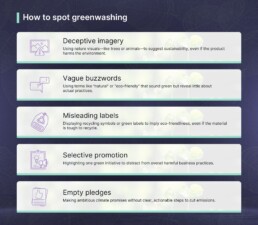
Legal measures
Regulations in Asia-Pacific
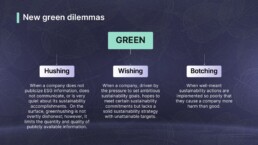
What YOU can do to fight greenwashing
How to spot greenwashing

Deceptive imagery

Vague buzzwords

Misleading labels

Selective promotion

Empty pledges



